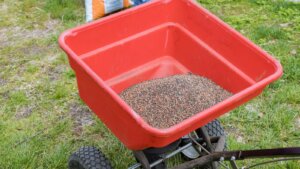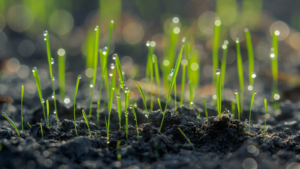Knowing the best time to mow your lawn is crucial for maintaining a healthy and vibrant lawn. The time of day you choose to mow can have a significant impact on the health and appearance of your grass. This comprehensive guide will help you understand the best and worst times to mow your lawn, ensuring it always looks its best.
Understanding the Best Time of Day to Mow
The best time to mow the lawn is late afternoon or early evening. During this time, the day’s heat has passed, but there’s still enough light to see what you’re doing. Mowing at this time allows the grass to heal before nightfall, reducing the risk of disease and fungal infections.
Mowing in the mid-morning, after the morning dew has dried, is the second best time to mow your lawn. The grass is dry, and the temperature is still relatively cool, which means less stress for the grass and for you.
Avoiding the Worst Time to Mow
When should you not mow the lawn? The worst time is in the middle of the day, especially during the summer months. The heat of the day can cause the grass to tear rather than being cleanly cut by the mower blade. This can lead to a higher risk of disease and pests.
Another time to avoid mowing is when the grass is wet. Wet grass can clog your mower and cause an uneven cut. It’s best to let the grass dry before you start mowing.
How Often Should You Mow?
The frequency of lawn mowing is largely dependent on the type of grass you have and its growth rate. As a general rule, you should aim to mow your lawn at least once every week during the growing season. However, if your grass grows quickly, you may need to mow more often.
The time of day you choose to cut grass is also crucial. It’s best to avoid mowing at midday when the sun is at its peak. The heat can stress the freshly cut grass and make it more susceptible to disease. Instead, aim for the cooler parts of the day, such as early morning or late afternoon. This gives your lawn time to recover before nightfall, which is the optimal time for healing.
Maintaining a Healthy Lawn
When you mow your grass, it’s important to give it time to recover. Cutting your lawn causes stress to the grass, and it needs time to heal. This is why you should never mow your lawn more than once a day. Instead, aim to mow your lawn every five to seven days. This gives your grass the ideal time to recover and grow back stronger and healthier.
Remember, the goal of lawn mowing is not just to keep your lawn looking neat, but also to keep it healthy. Using a well-maintained lawn mower and cutting your lawn at the right time of day can make a big difference in the health and appearance of your lawn. So, take the time to understand your grass type, monitor its growth rate, and adjust your mowing schedule accordingly. This way, you can maintain a healthy lawn that recovers well after each mow and looks its best at all times.
Mowing Height Matters
The height at which you mow your lawn is a critical factor in maintaining its health and vitality. When you mow your lawn, you should never cut more than one-third of the grass blade at a time. This is because cutting the grass too short, a mistake often referred to as “scalping,” can stress the grass and make it more susceptible to pests and diseases.
Another factor to consider is The time of day you choose to cut your grass plays a role in determining the best mowing height. For instance, if you mow your lawn in the hottest part of the day, the grass may lose more water and recover slower, which could necessitate a higher cut to help protect the grass. Conversely, if you mow in the cooler parts of the day, when the grass is less stressed, you might be able to get away with a slightly lower cut.
Maintaining Your Mower for Optimal Lawn Care
A well-maintained mower is not just a tool, but an essential partner in your quest for the perfect lawn. When you mow your lawn, the condition of your mower can significantly impact the health and appearance of your grass.
One of the key aspects of mower maintenance is keeping the blades sharp. Sharp blades ensure a clean, even cut, which is healthier for the grass. Dull blades can tear the grass, causing damage and making your lawn more susceptible to disease and pests. Therefore, it’s crucial to regularly check and sharpen your mower blades.
Cleaning your mower after each use is another important part of maintenance. Grass clippings and debris can build up on the mower, potentially harboring diseases that could spread to your lawn the next time you mow. By cleaning your mower after each use, you can help prevent the spread of disease and keep your mower running smoothly.
Lastly, consider the best time to cut your grass and the day to cut grass in your lawn care routine. Mowing at the right time can reduce stress on your grass and your mower, making your lawn care tasks more effective and efficient.
Final Thoughts on How to Mow Your Lawn Effectively
Knowing the best time of day to mow, how often to mow, and how much to cut off are all crucial aspects of lawn care. By following these tips, you can keep your lawn looking its best and avoid common problems like scalping. Remember, the goal is to keep your lawn healthy and beautiful, and the time of day you choose to mow can play a big role in achieving that goal.



